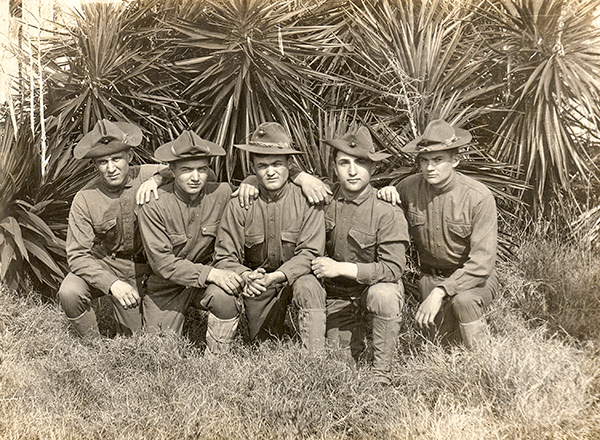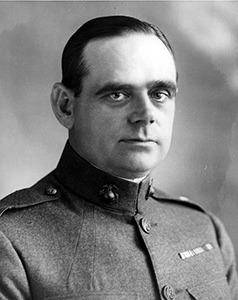U. S. Disciplinary Barracks, Port Royal
|

Marine brig guards
|
Following the 1911 closing of the officers' school and recruit program, one of the most interesting episodes in Parris Island’s history occurred when a naval prison was opened on the base. On Aug. 28, 1911, the designation of "U. S. Naval Station, Port Royal" was changed to "U. S. Disciplinary Barracks, Port Royal." Buildings used by the Marines were transferred to the Navy, and although the disciplinary barracks was commanded by a Marine officer and Marines served as guards, they were administratively under the direct command of the Navy. No Marine command per se existed for Parris Island from Aug. 30, 1911, to October 1915.
The transfer of naval prisoners from various brigs to Parris Island was accomplished by train and boat and was not without peril. Charles B. Hughes was one of 100 guards who transported 300 prisoners to Parris Island. During their journey, the train was "swept off the tracks by a tropical hurricane," requiring both the guards and prisoners to work for two days to rebuild roadbeds and repair tracks. Upon arriving at Parris Island, the prisoners were quartered in the old "quartermaster warehouse" Building 11, which was enclosed by a high wooden stockade-like fence with sentry boxes.
The prison emphasized rehabilitation rather than punishment. Prisoners were allowed to dress in regular service uniforms, and much of a prisoner's time was spent in drill and other military-related activities. The prisoners who were confined on Parris Island were usually general court martial recipients who were sentenced to no more than three years confinement for non-violent crimes. These offenses included absence without leave, embezzlement and similar crimes.
As of Sept. 1, 1912, a system was introduced whereby prisoners who had served one year without receiving any demerits would be classified as "probationers." These men were granted the same privileges as regular enlisted personnel and were treated as trustees. Prisoners with unsatisfactory records, or who had not served a year, were classified as "detentioners" and were more confined. Some of the prisoners were undoubtedly incorrigible or failed to cooperate with the guards. One punishment awarded these men was for guards to drill the prisoners carrying wooden-like rifles, which "were much heavier than the regular type." A model prisoner, upon completion of his sentence, was given the option of being less than dishonorably discharged or of being allowed to re-enlist and continue a military career. In 1915, the disciplinary barracks would be absorbed into the Marine barracks but would continue to function until 1933.
|

Lt. Col.
Charles B. Hatch
|
The commander of the prison was Maj. Charles Burbridge Hatch who joined the Marine Corps in 1898 and served as a second lieutenant on the USS Indiana during the Spanish American War. After the war, Hatch served at various Marine barracks and ship detachments. In 1908, he was assigned to duty at the Portsmouth Naval Prison. He went on to represent the Marines at a number of prison conventions and became a member of a board that studied and developed a system of punishments for military offenses. In August 1911, he was ordered to Port Royal where he established the Naval Disciplinary Barracks. While in command of the prison at Port Royal, Hatch was often detached for duties that took him to London and service with the expeditionary force in the Dominican Republic. In January 1915, he left Port Royal and was assigned to the Atlantic Fleet as division Marine officer. A year later, Hatch led Marine and sailor detachments in the capture of Puerto Plata, Dominican Republic. From June 1, 1916, through World War I, Hatch, then a lieutenant colonel, was stationed on recruiting duty. While in Philadelphia, he organized vice squads of Marines to help local authorities close illegal alcohol establishments. He was known as the "Marine Corps Vice Vigilante."